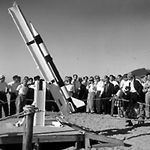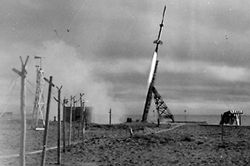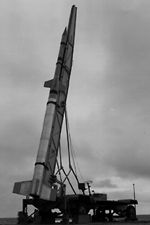Under the Limelight ---- The Kappa Era
The minimum altitude required to join IGY was supposed to
be 60-100 km. The sounding rocket team at the University of Tokyo continued
to launch and improve Baby rockets to accumulate basic data to attain
the required altitude.
The AVSA group had originally planned to go through A (Alpha),
B (Beta), K (Kappa), and  (Omega)
extending the scale one after another and to launch 20 kg instruments
up to 100 km altitude. To join IGY, however, the group happened to have
to speed up the pace of research and development. Thus the group proceeded
directly to Kappa type neglecting the intermediate stages. (Omega)
extending the scale one after another and to launch 20 kg instruments
up to 100 km altitude. To join IGY, however, the group happened to have
to speed up the pace of research and development. Thus the group proceeded
directly to Kappa type neglecting the intermediate stages.
Double Base Kappa
| The first three K-series, K-1, K-2
and K-3, adopted the double-base propellant of the Baby series. K-1,
128 mm in diameter, had an initial acceleration of 25 G and thundered
away at the instant of ignition. K-3 was the first two-stage Kappa.
Double-base propellant cannot be cast into a chosen shape of a large
size (1 cm diameter is the upper limit). When the double-base is to
be crammed into a large motor case, many units of double-base propellant
had to be packed inside, like umbrellas in an umbrella stand. |
 |
K-6 --- Adoption of Composite Propellant
 Composite-type
propellant, on the other hand, could be controlled in its shape, and enabled
a lightweight motor case utilizing internal burning. Thus K-4, K-5 and
K-6 employed composite propellant (polyester-type). But the development
of this type of propellant did not always meet a favorable wind. For example,
in its initial developmental stage, explosion followed ignition every
time. When a dealer of apparatus and materials for the experiments visited
the laboratory with his bill, all the staff often just stood there with
their mouths open in utter amazement, surrounded by fragments of motor
case and propellant. Composite-type
propellant, on the other hand, could be controlled in its shape, and enabled
a lightweight motor case utilizing internal burning. Thus K-4, K-5 and
K-6 employed composite propellant (polyester-type). But the development
of this type of propellant did not always meet a favorable wind. For example,
in its initial developmental stage, explosion followed ignition every
time. When a dealer of apparatus and materials for the experiments visited
the laboratory with his bill, all the staff often just stood there with
their mouths open in utter amazement, surrounded by fragments of motor
case and propellant.
Anyway, this new type propellant was put to practical
use in a year-long struggle. It was in June, 1958, that the group succeeded
in reaching the originally aimed summit altitude of 60 km by K-6 type
rocket after a successful flight test of K-5. K-6 was 25 cm in 1st stage
diameter, 5.4 m in total length and 255 kg in weight. Needless
to say, the composite-type propellant was a leading factor to reach 60
km altitude. Thus Japan could join the IGY program to observe wind, temperature
and cosmic rays data in the upper atmosphere.
K-8 - Opening to Large Sounding Rockets
 The
rocket group of University of Tokyo went on to develop the considerably
larger K-8 type. The main point of the K-8 project was a 420 mm-diameter
motor. The K-8 was a two-stage rocket with a 420 mm motor first stage
and a 250 mm motor (K-6 booster) second stage. A new type of composite
propellant (sulfide-type) with a large-diameter, metallic nozzle, welded
chamber of high-tensile steel and other technical barriers were cleared
and, in September 1960, the K-8-3 succeeded in observing ionosphere and
cosmic rays in the presence of NASA scientists. K-8 enabled a variety
of observation of space including the ionosphere and, as a full-fledged
sounding rocket, attracted considerable attention around the world. The
rocket group of University of Tokyo went on to develop the considerably
larger K-8 type. The main point of the K-8 project was a 420 mm-diameter
motor. The K-8 was a two-stage rocket with a 420 mm motor first stage
and a 250 mm motor (K-6 booster) second stage. A new type of composite
propellant (sulfide-type) with a large-diameter, metallic nozzle, welded
chamber of high-tensile steel and other technical barriers were cleared
and, in September 1960, the K-8-3 succeeded in observing ionosphere and
cosmic rays in the presence of NASA scientists. K-8 enabled a variety
of observation of space including the ionosphere and, as a full-fledged
sounding rocket, attracted considerable attention around the world.
In this way, the 3rd IGY gave an opportunity for the scram of space science
and space technology which has been recognized to be one of the extraordinarily
strong points of Japanese space science. |